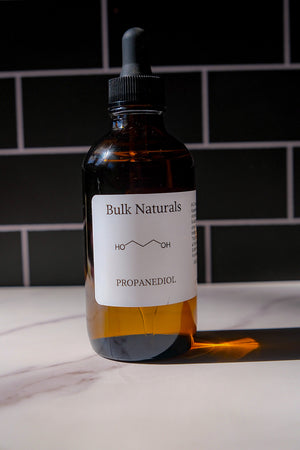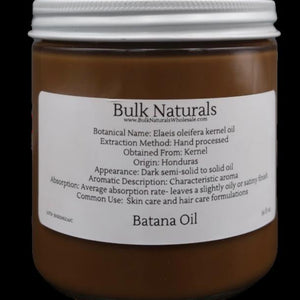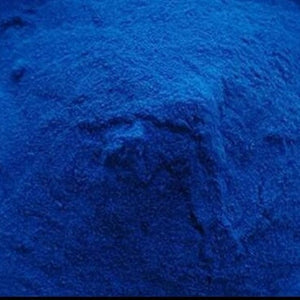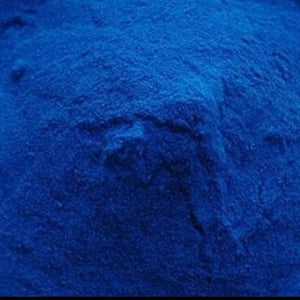Hyperpigmentation can affect anyone—regardless of age, skin tone, or skin type. Whether it shows up as sun spots, melasma, post-acne marks, or dull, uneven tone, the root issue is the same: excess melanin production triggered by external or internal stressors.
The good news? You don’t have to rely on harsh synthetics to even your skin tone. Nature provides an impressive toolkit of botanical ingredients that help brighten, soothe, and restore skin’s clarity—gently and effectively. In this guide, we’ll walk through the causes of hyperpigmentation, ingredients that truly work, and how to build a complete brightening routine using high-performance raw materials from Bulk Naturals Wholesale (BNW).
What Causes Uneven Skin Tone & Hyperpigmentation?
Hyperpigmentation is one of the most common skin concerns across all skin tones and types. At its core, it results from an increase in melanin, the pigment responsible for the color of your skin, eyes, and hair. When this pigment is unevenly distributed or overproduced, it leads to visible discoloration—such as dark spots, melasma, post-inflammatory hyperpigmentation (PIH), or overall dullness.
But what causes this melanin imbalance in the first place?
1. UV Exposure
One of the most well-known and consistent triggers, ultraviolet (UV) radiation stimulates melanocyte activity—the skin cells that produce melanin. Even short periods of sun exposure without protection can lead to long-term pigment changes. Over time, repeated sun exposure can result in sunspots, freckles, or solar lentigines, particularly on the face, chest, and hands.
2. Post-Inflammatory Hyperpigmentation (PIH)
When your skin experiences inflammation—from acne, eczema, bug bites, cuts, or burns—it can respond by overproducing melanin as part of the healing process. This is especially common in deeper skin tones, where inflammation can linger and result in persistent dark marks after breakouts or irritation.
3. Hormonal Changes
Conditions like melasma (often called the “mask of pregnancy”) are linked to hormonal shifts from pregnancy, birth control, or hormone replacement therapy. These fluctuations can make melanocytes more sensitive to environmental triggers—especially UV light—leading to stubborn patches of discoloration that resist treatment without hormonal balance.
4. Aging & Slower Cell Turnover
As we age, our skin’s natural renewal process slows down, which means pigmented cells linger on the surface longer. In addition, cumulative sun damage and oxidative stress compound the issue, creating a dull, uneven complexion and more noticeable dark spots.
5. Skin Trauma or Over-Exfoliation
Ironically, attempts to “fix” hyperpigmentation with harsh scrubs, peels, or strong acids can actually worsen it. Over-exfoliation damages the protective skin barrier, increases inflammation, and triggers melanocytes to produce even more pigment as a defense mechanism.
The Role of Melanocytes
In all of these scenarios, the key players are melanocytes—specialized cells located in the basal layer of the epidermis. These cells produce melanin and transfer it to surrounding skin cells to protect against perceived damage. When overactive, they flood the skin with excess pigment, which accumulates and shows up as uneven tone.
Successfully targeting hyperpigmentation means addressing melanocyte activity at the root, while also healing and protecting the skin from ongoing triggers. A truly effective solution combines brighteners, soothers, gentle exfoliants, and barrier-repair ingredients in a balanced, non-irritating formula.
Whether you’re formulating for acne-prone teens, aging complexions, or post-procedure care—Bulk Naturals Wholesale offers botanical actives and functional ingredients that support skin safely and naturally.
A Natural Approach to Brightening
The Key Pillars of a Holistic Approach to Hyperpigmentation
Achieving even-toned, radiant skin doesn’t happen overnight—but it also doesn’t require stripping your skin or relying on harsh bleaching agents. A truly effective, long-term strategy for fading hyperpigmentation focuses on treating the root causes while nurturing the skin barrier. That’s where the holistic approach shines.
✅ Brighteners – Reduce Melanin Overproduction
Hyperpigmentation begins when the skin produces too much melanin in response to stressors like UV exposure, inflammation, or hormonal shifts. Natural brighteners work by safely inhibiting tyrosinase, the enzyme responsible for melanin production. Gentle botanical brighteners such as Alpha-Arbutin, Licorice Root, and Niacinamide can gradually fade dark spots without irritation—making them ideal for daily use in all skin tones.
✅ Soothers – Calm Inflammation and Prevent New Pigment
Inflammation is one of the biggest drivers of hyperpigmentation, especially post-acne marks or melasma. If your skin stays irritated, it’s more likely to overproduce pigment—even from minor triggers. Ingredients like Panthenol, Aloe Vera, Propolis, and Manuka Hydrosol help to calm the skin, reduce redness, and interrupt the cycle of inflammation-induced pigmentation.
✅ Renewers – Gently Support Cell Turnover
To fade discoloration that’s already visible, the skin needs help shedding pigmented cells and encouraging new ones to surface. But aggressive exfoliation can worsen hyperpigmentation. Instead, use natural enzyme exfoliants like Papaya Extract or Manuka Honey, which support healthy desquamation without stripping the barrier. This gradual renewal process keeps skin smooth, fresh, and more receptive to brightening treatments.
✅ Barrier Boosters – Strengthen and Protect Skin’s Defenses
A compromised skin barrier makes it harder for your skin to heal, more vulnerable to inflammation, and less able to tolerate brightening actives. That’s why any pigmentation protocol should include ingredients that reinforce and protect the skin’s moisture barrier—like Squalane, Royal Jelly, and Glycerin. These ingredients maintain hydration, increase resilience, and help active ingredients perform more effectively over time.
Key Natural Ingredients for Hyperpigmentation & Uneven Skin
Botanical Brighteners
Alpha-Arbutin (Natural)
A plant-based, stable compound that works by inhibiting tyrosinase—an enzyme involved in melanin production. Unlike hydroquinone, Alpha-Arbutin brightens gradually without bleaching or sensitizing the skin. It’s safe for all skin tones and effective with consistent use.
Formulation Idea:
Add to water-based serums, eye creams, or spot treatments at 1–2%.
Add to water-based serums, eye creams, or spot treatments at 1–2%.
Licorice contains glabridin, which targets pigmentation while also soothing redness. It inhibits melanin production and reduces inflammation, making it excellent for post-acne dark spots and sensitive skin.
Best For:
Toners, gels, and lightweight brightening serums.
Toners, gels, and lightweight brightening serums.
Bioactive Peptides & Postbiotic Brighteners
Skin Lightening Peptide (Lactobacillus Ferment Lysate Filtrate):
This innovative ingredient combines the power of bio-fermentation with precision peptide technology. As a lysate derived from the fermentation of Lactobacillus, this filtrate offers gentle yet targeted support for brightening, calming, and barrier protection.
Why It Works:
Lactobacillus Ferment Lysate Filtrate works by interrupting the melanin production process, helping to reduce the appearance of existing discoloration while minimizing the formation of new spots. It also supports the skin’s microbiome and natural defense mechanisms, making it especially valuable for sensitive, reactive, or post-inflammatory skin types.
Lactobacillus Ferment Lysate Filtrate works by interrupting the melanin production process, helping to reduce the appearance of existing discoloration while minimizing the formation of new spots. It also supports the skin’s microbiome and natural defense mechanisms, making it especially valuable for sensitive, reactive, or post-inflammatory skin types.
Skin Benefits:
-
Helps brighten uneven tone and dark spots
-
Supports a healthy skin barrier and microbiome
-
Calms redness and post-inflammatory pigmentation
-
Boosts hydration retention and skin comfort
Use:
Incorporate at 1–3% in serums, spot correctors, water-based gels, or overnight masks. Ideal for formulations where gentle brightening with barrier support is the goal.
Incorporate at 1–3% in serums, spot correctors, water-based gels, or overnight masks. Ideal for formulations where gentle brightening with barrier support is the goal.
Pro Tip:
Pair with niacinamide and licorice root extract in post-acne serums or use alongside alpha-arbutin in leave-on treatments for a multi-layered approach to hyperpigmentation.
Pair with niacinamide and licorice root extract in post-acne serums or use alongside alpha-arbutin in leave-on treatments for a multi-layered approach to hyperpigmentation.
Enzyme-Based Exfoliation
Papain gently dissolves dead skin cells, revealing brighter, smoother skin underneath. Unlike abrasive scrubs, enzyme exfoliants are ideal for sensitive skin and can improve absorption of other brighteners.
Use Tip:
Include in weekly masks, cleansers, or exfoliating creams.
Include in weekly masks, cleansers, or exfoliating creams.
This water-soluble extract provides gentle enzymatic action while soothing and hydrating the skin. It supports healing, barrier repair, and post-inflammatory recovery.
Bonus:
Also offers antimicrobial benefits for acne-prone skin.
Also offers antimicrobial benefits for acne-prone skin.
Barrier Boosters & Inflammation Fighters
One of the most versatile and research-backed skincare ingredients, Niacinamide improves skin tone, reduces discoloration, supports barrier function, and decreases inflammation.
Usage:
Use at 2–5% in daily serums, moisturizers, or toners.
Use at 2–5% in daily serums, moisturizers, or toners.
A moisture magnet and skin soother, Panthenol is key in reducing post-acne inflammation and supporting healing, helping to prevent PIH (post-inflammatory hyperpigmentation).
Usage:
Use at 1–5% in water-based serums, toners, or gel masks. Combine with humectants like glycerin and soothing botanicals for a calming, barrier-repairing formula.
Usage:
Use at 1–5% in water-based serums, toners, or gel masks. Combine with humectants like glycerin and soothing botanicals for a calming, barrier-repairing formula.
Squalane mimics the skin’s natural oils, offering hydration without clogging pores. It helps buffer more active ingredients and keeps the skin barrier strong and resilient.
Use In:
Cleansers, emulsions, overnight masks, and oils.
Cleansers, emulsions, overnight masks, and oils.
Daily Routine Suggestions for Hyperpigmentation
Morning Routine:
-
Cleanse: Use a cream or oil-based cleanser to avoid stripping the skin.
-
Tone: Mist with Manuka Hydrosol + Panthenol for a calming boost.
-
Serum: Apply a brightening blend of Niacinamide (5%) + Alpha-Arbutin (2%).
-
Moisturize: Use a light lotion featuring Licorice Root Extract + Squalane.
-
Protect: Always apply SPF 30+ as your final step.
Evening Routine:
-
Repeat cleanse & mist.
-
Use a hydrating treatment or mask that includes Manuka Honey Extract WS.
-
Use brightening serum.
-
Seal with richer moisturizer or a barrier-repair balm.
DIY Brightening & Soothing Serum (30g Batch)
A beginner-friendly recipe that blends humectants, brighteners, and botanical extracts for daily use.
Ingredients:
-
Distilled Water – 22.85g (76%)
-
Glycerin – 0.9g (3%)
-
Niacinamide – 1.5g (5%)
-
Alpha-Arbutin – 0.6g (2%)
-
Panthenol – 0.3g (1%)
-
Liquid Licorice Root Extract WS – 2.4g (8%)
-
Geogard® ECT – 0.3g (1%)
-
pH Adjuster – as needed
Instructions:
-
Combine all actives in water and mix until fully dissolved.
-
Add licorice extract, then preservative.
-
Adjust pH to 5.0–5.5 and store in dropper bottle.
Formulation Tips for Success
-
Formulate at pH 5–6 for ingredient stability and skin compatibility.
-
Layer ingredients smartly: Use water-based serums first, then lock in with creams or oils.
-
Introduce slowly: Start with 1–2 actives, then build as your skin adapts.
How Long Does It Take to See Results?
Hyperpigmentation fades gradually—typically over 4 to 12 weeks. Results vary depending on skin type, depth of discoloration, and how consistently you apply your products. Consistency and gentle care are key.
Bonus Ingredients to Watch
If you're building a brightening product line or custom routine, consider incorporating:
-
Bakuchiol – A plant-based retinol alternative for gentle skin renewal.
-
Royal Jelly Extract – Helps support skin regeneration and improve elasticity.
-
Aloe Vera 100x Powder – Delivers deep hydration and reduces irritation.
-
Propolis Extract G – Soothes inflammation and protects the skin barrier, ideal for acne-prone skin.
Final Thoughts: Bright Skin, Naturally
Uneven skin tone doesn’t require harsh treatments or a complicated routine. With the right blend of nature-backed ingredients, consistent use, and a gentle approach, you can fade hyperpigmentation, restore radiance, and keep your skin healthy and glowing.
At Bulk Naturals Wholesale, we’re proud to offer ingredients that bridge tradition and science—empowering both formulators and everyday users to create high-performance, skin-supportive products.
👉 Shop Now









Thank for the very informative information! I really need to make some facial serums for skin problems. I see a lot of women with uneven skin tones of the face of the type,Hyperpigmentation. Other common type is scaring of marks after acne break outs. I need a receipe to make some! May order soon of whats recommended here.
Leave a comment